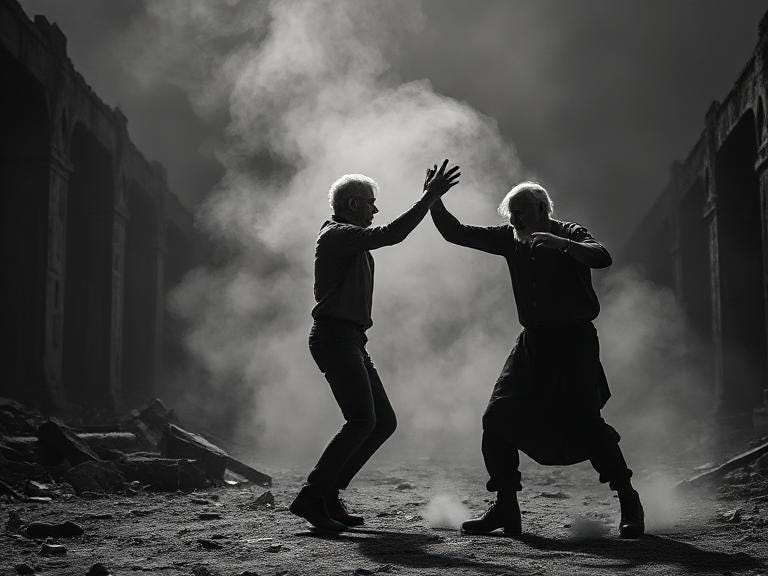A Family-Sized Digital Detox
The internet is still gone.1
For almost 48 hours now, the silence has been humming in the background of everything I do. I wake up and check my phone out of habit. Still nothing. No updates. No news. No unread messages.
I try to picture what my family is doing during this state-imposed summer vacation. They’ve been pushed out of Tehran like dust swept off a desk; no plan, no timeline, just the vague goal of being somewhere else.
So I imagine them around a breakfast table. Are they talking about what’s next? Are they deciding whether to go for a walk or stay inside? Who’s cooking today? Will they remember to make Shirazi salad?
Is anybody telling a joke? Are they laughing? And in these images, they don't look like normal human beings; they look like perfect stereotypical people that you can only see in dreams.
With no internet to scroll, no Telegram alerts to tap into, are they accidentally bonding?
I google “benefits of digital detox.” It gives me a list: reduced stress and anxiety, improved sleep, enhanced focus, stronger relationships, better health.
Could they be experiencing all of the above? Or are they just bored out of their minds? I don't know.
May the Grapes Ripen
I come across a friend’s post: a poem in Farsi.
It’s a short poem, almost a prayer. A wish for grapes to ripen so we can make wine.
But it isn’t really about wine. It’s about what wine can do. What it can undo. Through the image of fruit turning sweet in the sun, the poem imagines a world swaying gently out of its misery.
Where presidents and beggars drink together. Where weapons forget what they’re made for. Where love, not war, becomes contagious. Where the streets are drunk, the world a little tipsy, the borders dizzy enough to forget they exist.
Wouldn't that be great?
Kinds of Kindness
In between the terrible headlines and the catastrophic footage, something else is circulating:
A man, still in his car, recounts what happened at a local bakery. News broke that only 12 loaves of bread were left for all the customers waiting in line. So they decide to divide the bread, some taking less than they needed so others could have a share. No pushing, no shouting, no panic.
Another video.
A man returning from the supermarket explains how he usually calculates prices in his head before getting to the cashier.
“But the number he said was lower than what I had in mind,” he says, still sounding surprised. He told the shopkeeper there must be a mistake.
“No, sir,” the man behind the counter said. “I’m charging you only what I paid. No profit. Not in times like these.”
Then, there’s the one.
A man and his daughter, no older than five or six, walking along a line of cars baking under the Tehran sun, offering cold drinks to drivers waiting for gas.
And I remember the early days of COVID.
How quickly supermarket shelves emptied. How people hoarded and closed their doors. I remember the loneliness, the survival mode. And how different it feels now, watching people offer what little they have without being asked.
Improvising Contact
Today, during a casual exchange in a work context, I learned about something I’d never heard of before: contact improvisation jam.
Apparently, it’s a global practice among dancers. A kind of open session where people move together, share weight, respond to touch, and explore physical awareness through spontaneous, unscripted movement.
I admitted, honestly, that I’d never encountered this concept before. My colleague was surprised. “Really? It’s practiced almost everywhere,” they said.
“Maybe I didn’t know about it because I’m from a place where touch is forbidden,” I offered.
To hear that there’s a space where people gather without hierarchy, without agenda, just to move and respond to one another, sounded quietly radical.
I joked, half-serious: “I think we need dancers to save us from this absurd situation.”
Then I pictured it: the international court orders the Angry Men responsible for this war to attend weekly contact improv sessions.

Can You Lean on Your Friend?
I finally make it to the somatic session my friend offered me a few days ago.
We start with cherries, those small summer wonders, and ease into a conversation about trauma, the kind that gets quietly stored in the body. We talk about the strangeness of receiving bad news while standing upright, about how the body takes the blow even when the mind is trying to make sense of it.
Then we begin.
My stiff body and her strong healing hands start a dialog. We’re not rushing, but I still expect something: an outcome, a transformation, a moment of release that proves I’ve done this right. I slip into my oldest habit, the one that got me through school and life in general: be the top student. Do it well. Be good.
“We’re not following a goal here,” she reminds me gently. “This is not about achieving something. We’re just exploring.”
Right. Exploring. I let that sink in.
The practice begins from the top of the head to the soles of the feet, and we move slowly. She guides, I listen, and occasionally describe the sensations.
Then she asks me to sit and lean my body into hers. Not symbolically. Physically. Just lean. Without tension.
It sounds simple, but it’s not.
I try. I overthink it. My legs lock. My shoulders pull away. The right half of my back tightens, my head floats just above her shoulder without resting. I’m doing something, but it’s not leaning.
‘How do you lean, really?’
I don’t know. Not yet.
I wrote this on June 20, the 8th day of the attacks, and published it on June 26.




